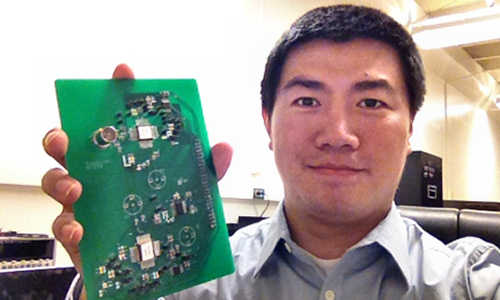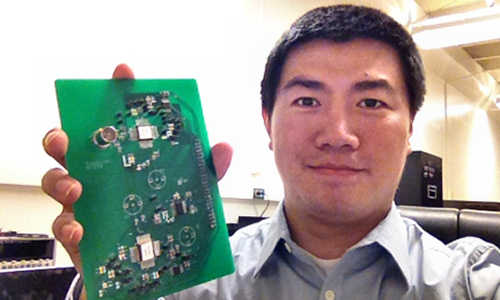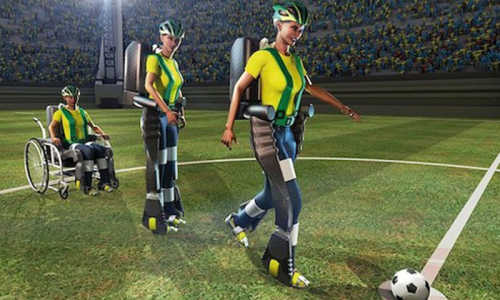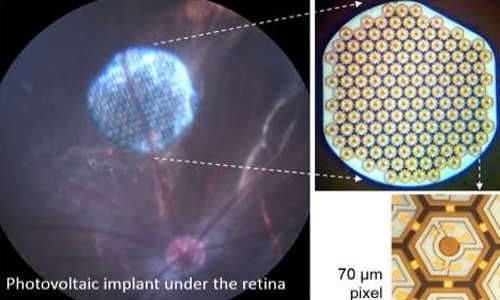Wei Tang, assistant professor of electrical and computer engineering at New Mexico State University, is taking a cue from nature to devise the next generation of integrated low-power, wearable micro-devices.
New Mexico State University electrical and computer engineering Assistant Professor Wei Tang shows a test platform of an asynchronous radio that he designed for transmitting data from the next generation of integrated low-power, wearable micro-devices. Photo Credit: Image courtesy of New Mexico State University (NMSU)
The human brain inspired his approach in the novel design of a system of state-of-the-art miniaturized sensors that can detect, transmit and reliably process valuable data.
Wireless sensors already enjoy widespread use in health care, surveillance, smart buildings, disaster mitigation and environmental monitoring. But the expectation of next-generation devices is that they be small enough to wear on clothing, a hat or eyeglasses.
Tang plans to use current sensor technology using a new design strategy to construct better circuits to build a bridge between the human body and the environment. The broad goal of his work is to extend our ability to sense the world and better respond to the environment and to develop medical devices that can be used for rehabilitation or to prevent and detect disease.
“The challenge of designing wearable devices is to make sensors that require very, very low power consumption and have a very, very small circuit area,” Tang said.
“My idea is to learn from nature how our brains and bodies work,” Tang said. “Our brain is a kind of a circuit. It has some big differences if you can compare it to a computer. Our brain has some big advantages. Our brain runs at very low power and is quite compact. A computer is constantly running at a very fast speed and the battery may last only one day. They are also too large.”
Computer code represents information as groups of 1s and 0s, or bits. The information has different weights making it a hierarchical, weighted system. The human brain transmits information through a series of neurons, all of which have different functions, but all of which carry the same weight, making a non-weighted system. The frequency with which neurons transmit information in the brain varies, so that the body can determine different types of information.
“Our brain is an asynchronous non-weighted machine and a computer is a synchronous weighted machine,” Tang said. “This is what I learned from a neuron science class,” he added. “I think we can borrow from this idea to build our next-generation circuit.”
Synchronous devices, such as computers, are constantly running code and communicating, even if there is no information to be sent. As a result, they waste a lot of energy. But if one thinks about humans having a conversation, they don’t need to have processes constantly running to synchronize words. Tang proposes to replace synchronous devices with devices that work more efficiently, like the human brain.
“I think we can replace current radio devices that use synchronous information to use asynchronous information – that is the first part. We developed a radio device with small circuits. We want to demonstrate that this radio can communicate to another radio using very low power consumption,” Tang said.
“The next part is to process the information. We created a very small integrated circuit, 3 millimeters by 3 millimeters. After testing this device, we want to put it on a hat with a small battery to extract EEG brain wave information. A patient or someone could wear it for a day or even up to a week. It would provide doctors with information to analyze.”
An EEG, or electroencephalogram, is a test that measures and records the electrical activity of the brain. Sensors are attached to a patient’s head and hooked by wires to a computer that records the brain’s electrical activity and diagnoses problems such as epilepsy.
Because the power consumption of Tang’s sensor device is so low, he is planning to devise some sort of energy-harvesting device, using energy from vibrations or solar energy. That way, the sensor would no longer require a battery and would become power independent, Tang’s ultimate goal.
The application of this technology is broad, indeed. Tang has collaborated with two researchers from NMSU’s Biology Department.
Associate Professor Timothy Wright is using a hummingbird feeder that uses Radio-Frequency Identification to give birds access to the nectar. Tang’s group designed a controller, a detection mechanism to alert the feeder when a bird is near and data logging. The feeder was constructed by the College of Engineering’s Manufacturing and Technology Engineering Center. Wright’s group conducted research with the feeder in Costa Rica last year. The study relates the cognitive abilities of the birds to their ability to defend their territories.
In another study, Professor Graciela Unguez has been working with Tang to use his technology to assist in her study of electric fish that are able to produce weak electric fields and use this ability to sense their environment, choose a mate and identify members of their own species.
Tang is developing a tiny device that can be placed on the fish to collect data about their behavior.
This study is important to the future of using sensors that can reliably transmit information through water, leading the way for devices that can be implanted in the human body or submersed in water, or built into concrete structures for measuring mechanical stress, for instance.
“There are applications everywhere: industry, environmental, security, biomedical,” Tang said. “Everywhere we see the need for the next-generation computer that is miniature.”
Story Source:
The above story is based on materials provided by New Mexico State University (NMSU).






